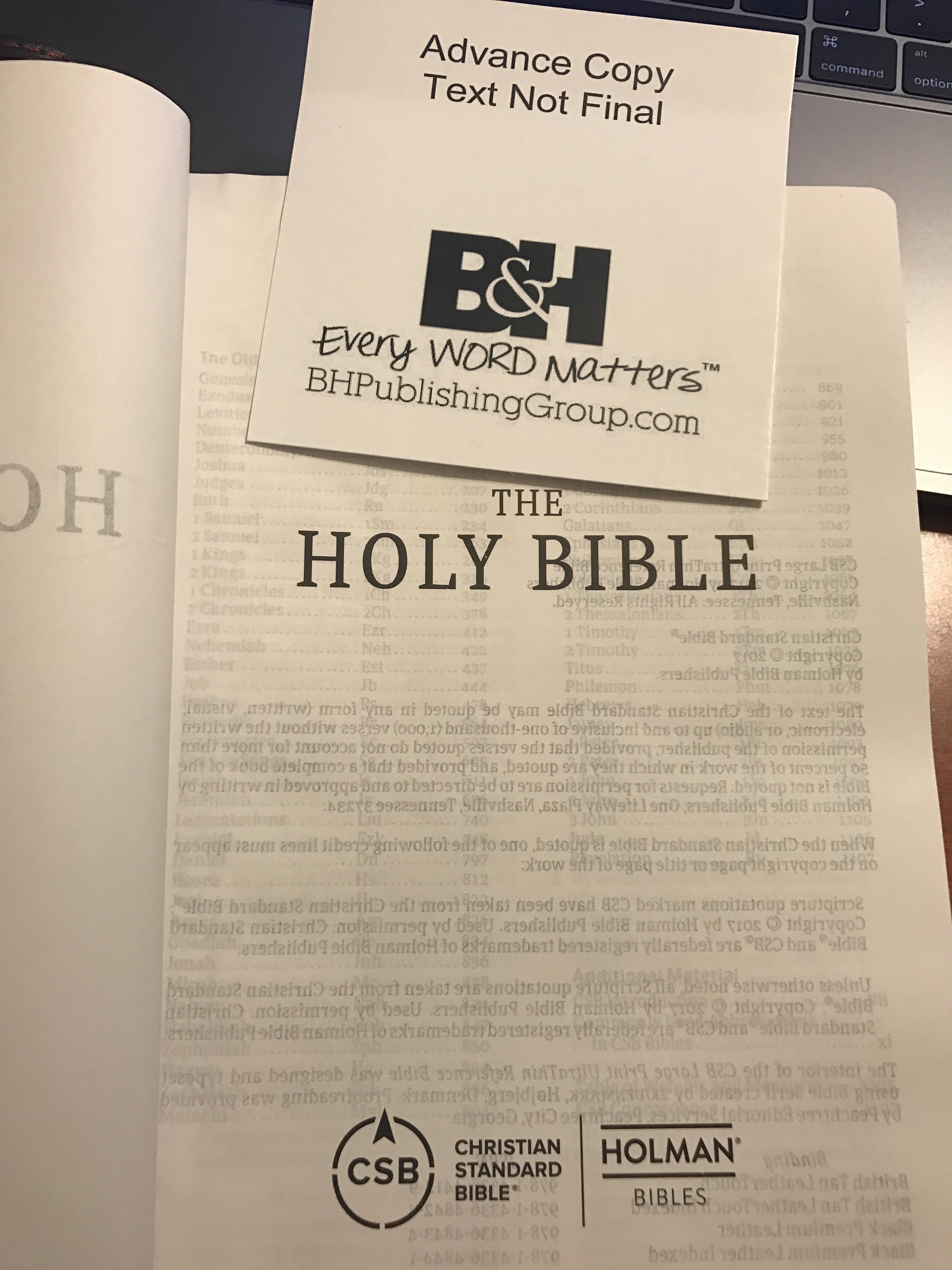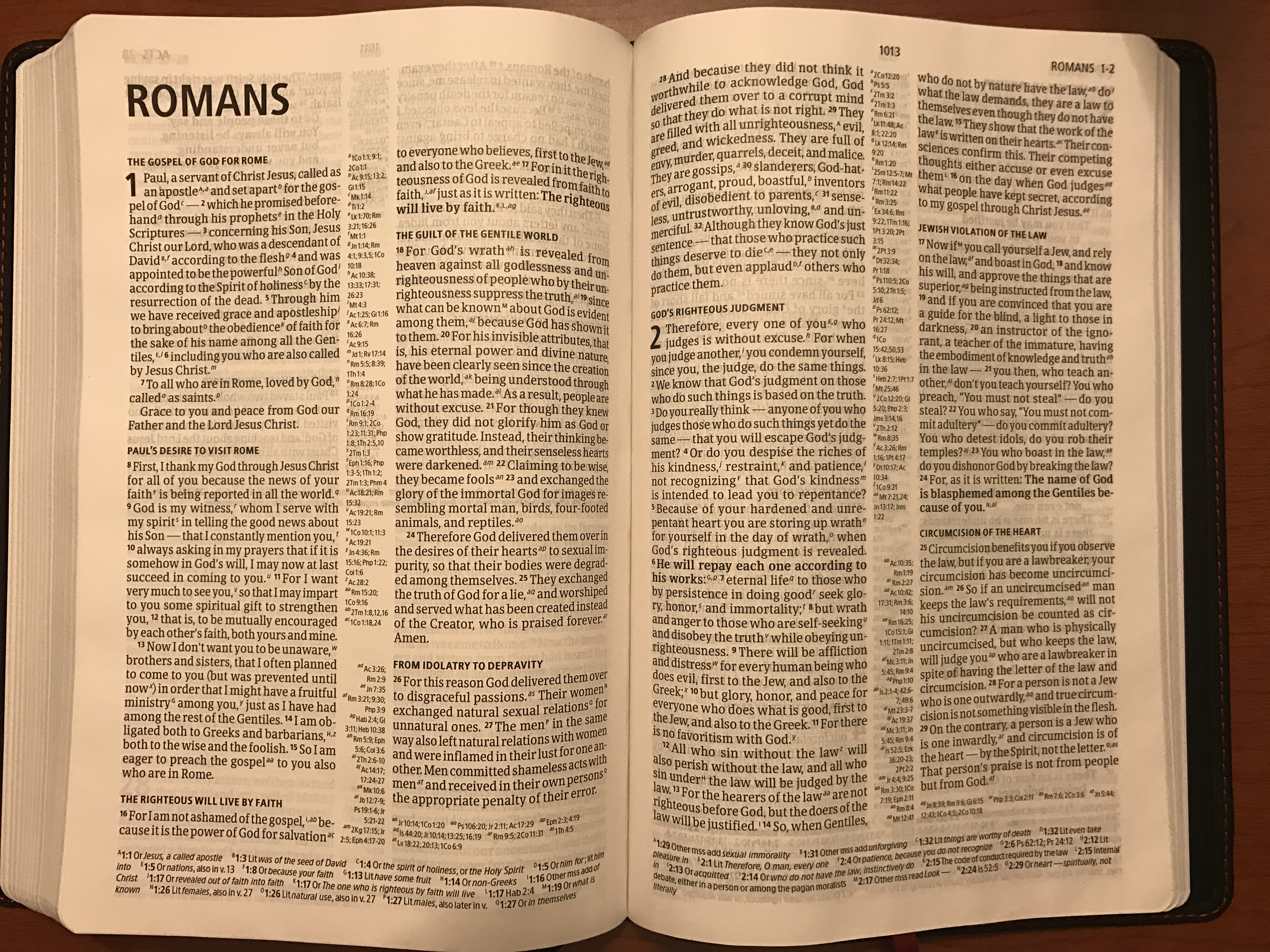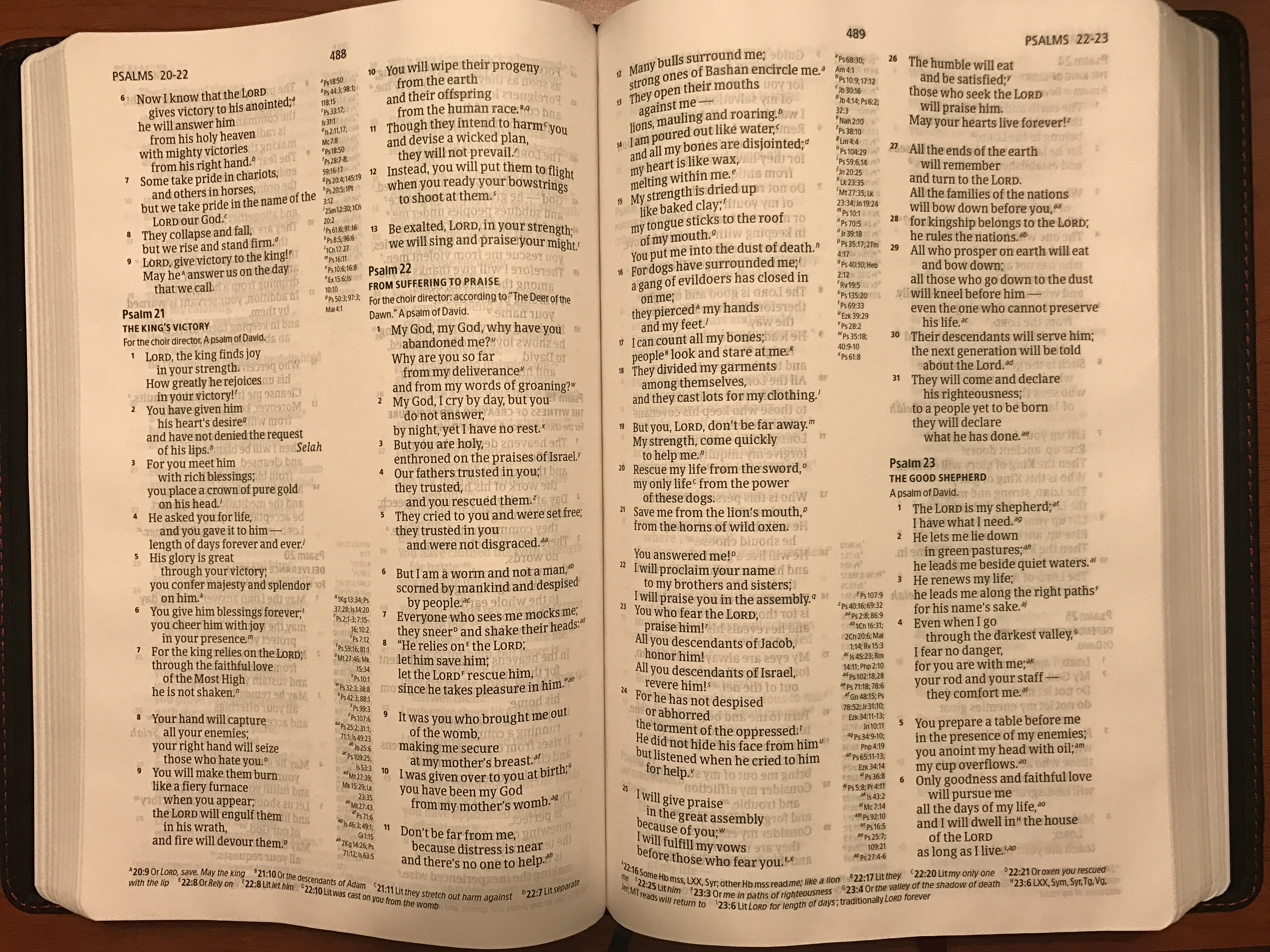2017 Christian Standard Bible (CSB): First Look [updated]
 Saturday, November 19, 2016 at 11:04PM
Saturday, November 19, 2016 at 11:04PM I had an "off-the-record" conversation with one of the original HCSB translators. I don't feel comfortable communicating everything I was told, but he informed me that except for a stylist or two, the entire translation committee of the HCSB was replaced with an entirely new team. The edition of the new CSB handed out earlier this week does not list the translation team, but a cardstock page in the box referred to Dr. Thom Schreiner as "Co-Chairman, Translation Oversight Committee." Schreiner is a premier Evangelical scholar for whom I have great respect, and I will be interested to learn who else was on the committee.
An employee of Lifeway told me that the text in the copy of the CSB given to attendees is very close to final form, but there may still be a "grammatical correction or two" before print copies go on sale in 2017.
- All HCSB bullet notes have been removed.
- All 645 instances of Yahweh in the HCSB have been replaced with the more traditional LORD (all caps).
- Surprisingly (to me), beer has (correctly) been retained for the Hebrew שֵׁכָר/šēḵār.
- Pronouns referring to deity are no longer capitalized.
- Thankfully, other than the changes in capitalization, John 3:16 is still correctly translated as "For God loved the world in this way [οὕτως/houtōs]: He gave his one and only Son, so that everyone who believes in him will not perish but have eternal life."
- According to the former HCSB translator I spoke with, the new CSB uses the title Messiah much less often than the HCSB, which used it 116 times in the New Testament for Χριστός/Christos. Note, for instance, the use of Christ in Matt 1:16 of the CSB as opposed to the HCSB's Messiah.
- Contractions have been retained in spoken dialogue. Whether they have been increased or decreased in frequency is unknown without an electronic text to search.
- The textual basis for the CSB is the BHS5 for the Old Testament and the NA28/UBS5 for the New Testament.
- The term "Optimal Equivalence" has been retained as a way of describing the HCSB as a median translation between Formal and Dynamic Equivalence.
- The introduction makes note that traditional words such as justification, sanctification, and redemption are used "since such terms have no other translation equivalent that adequately communicates their exact meaning." Interestingly, though, I discovered that the HCSB's use of proptiation in Rom 3:25 (ἱλαστήριον/hilastērion); Heb 2:17 (λάσκομαι/hilaskomai); 1 John 2:2 (ἱλασμός/hilasmos); 4:10 (ἱλασμός/hilasmos) has been changed to follow the NIV's lead with the phrase "atoning sacrifice" in all of the instances except Heb 2:17 where it is translated "to make atonement."
I have not had time to give a close look at the CSB, but from what I can see it is not a minor revision of the HCSB. Rather, as Lifeway seems to be positioning it, the CSB is new translation where every verse of its predecessor seems to have been up for change if necessary. Think NEB to REB, RSV to NRSV--or perhaps more appropriate in this case, RSV to ESV.
And the ESV may be the actual catalyst in all this. The ESV has continued to gain in popularity and use in conservative American Protestant churches, so it's no surprise that the new CSB would be more traditional in a significant number of places than the HCSB (such as the Beattitudes in Matthew 5 reverting to the traditional "Blessed are..." formula of older translations).
No doubt the HCSB has always used more natural English than the ESV, but perhaps the CSB is an effort to sound natural and retain a sense of the familiar at the same time, thus possibly allowing for more widespread use than it has received to date.
My main quibble with the changes is the loss of Yahweh for the Divine Name (יְהוִה/YHWH). Yes, I know the arguments: we don't know the exact pronunciation, and use of the name is offensive to some with Jewish backgrounds. For the latter issue, a speaker needs to be sensitive to his or her audience. Neverthless, I have a problem with the use of the word Lord/LORD because (1) it is a title, not a name; and (2) it is a not a word in use outside religious circles in our culture and loses nearly all original meaning when used for God.
Having taught from the HCSB at church for the last decade, I will give the CSB the benefit of the doubt and begin using this advance copy immediately in that setting in an attempt to really give it a fair shake. I especially look forward to an electronic version in Accordance so that I can more easily compare the CSB with the HCSB, which I somehow feel had too short of a lifespan in the big picture.




 R. Mansfield
R. Mansfield
I left off one note of interest.
Use of slave for δοῦλος/doulos has been changed to servant in most passages such as Romans 1:1.
 R. Mansfield
R. Mansfield
Another note of interest:
I can't believe I missed this (truth be told, I didn't even check), but in a number of places, the CSB more accurately translates ἀδελφοί/adelphoi as "brothers and sisters" where the context warrants it. I'm very glad to see this. No one would stand in front of a congregation of men and women and only say, "Brothers." The plural word ἀδελφοί/adelphoi usually means "brothers and sisters" when Paul is addressing an entire congregation in general terms; and thus, this rendering in these instances should be seen as more accurate and even more literal.
Correction:
According to commenter "Bible Geek," the CSB Bible given away at ETS is actually goatskin leather. I would not have dreamed that such a nice binding would be given away for free, especially considering the amazing things being done with imitation leather materials these days. Therefore, I assumed the Bible I received was imitation leather as the box did not actually say.
 CSB,
CSB,  HCSB in
HCSB in  Faith & Reason
Faith & Reason 


Reader Comments (37)
Very interesting post! Based on what you've posted it appears that two things on my CSB wishlist have been fulfilled in dropping Yahweh and Messiah for the traditional readings. Two questions:
1) Does your preview copy have a plan of salvation in the front of the Bible? This is one thing on my wishlist.
2) Are brackets used for disputed passages in NT such as the doxology of the Lord's Prayer in Matt 6:13b and John 5:3.b-4?
How does 1 John 5:7 read? The current HCSB has the TR/MT reading in a footnote that reads:
"Other mss (Vg and a few late Gk mss) read testify in heaven: the Father, the Word, and the Holy Spirit, and these three are One. 8 And there are three who bear witness on earth:"
Is this reading in the text?
Also have you heard anything about a digital strategy? I see plenty of CSB Bibles on Amazon, but no eBooks.
Thanks and God bless.
I thought the HCSB's use of "Yahweh" was a good balance between the Jewish superstition of never using the name and using it to excess for people. Unfortunately pretty much every change I see makes this the "NIV 2017" except for John 3:16.
Interesting post. I will probably miss seeing the name "Yahweh" in the text, but at least the team moved toward consistency in rendering the divine name. I, too, am interested in how the CSB handles disputed texts. I also wonder if the use of the word "slave" to translate "doulos" has been moderated a bit; Romans 1:1 in HCSB has Paul referring to himself as a "slave," while the CSB has "servant."
I like what I see so far; I haven't had time even to search the photos you posted thoroughly, but aside from the changes you mentioned, I can't see a major difference between HCSB and CSB. Granted, the sample size is small, so I look forward to reading your insights as you employ the translation on a regular basis.
Hoshie, here are a few answers to your questions.
There is no plan of salvation at the beginning of the CSB Bible I received. However, keep in mind that this is just one edition. There are over 100 different editions planned for publishing in the first half of 2017.
The texts you are referring to in Matt 6:13b and John 5:3b - 4 are not in brackets and actually not included in the main body of the text, but are reduced to footnotes.
Here is how the first reads:
Matt 6:13--
And do not bring us
into temptation
but deliver us from the evil one.
There is a footnote that reads "Or from evil; some later mss add For yours is the kingdom and the power and the glory forever. Amen."
John 5:3-5--
3 Within these lay a large number of the disabled--blind, lame and paralyzed. 5 One man was there who had been disabled for thirty-eight years.
Note that the versification above jumps from 3 to 5--v. 4 is left out entirely. There is a footnote that reads "Some mss include vv. 3b-4: --waiting for the moving of the water because an angel would go down into the pool from time to time and stir up the water. Then the first one who got in after the water was stirred up recovered from whatever ailment he had."
Here is 1 John 5:7--
For there are three that testify:
And then the footnote reads "A few late Gk mss and some late Vg mss add testify in heaven: the Father, the Word, and the Holy Spirit, and these three are one. And there are three who bear witness on earth:"
As for digital strategy, yes, I have heard things but since I have heard them through my position with Accordance Bible Software, I don't think it would be appropriate to mention what I've heard.
Chad, your statement regarding the use of "servant" instead of "slave" reminded me that I meant to mention that in the original blog post. I talked to a -second- member of the original translation team who told me they had made this change.
I find the use of footnotes in place of brackets to be an encouraging change. Do you know if the translation of Philippians 2:7 is the same in the CSB as it was in the HCSB? For some reason, the HCSB's rendering of the last part of that verse never sounded quite right to me: "And when He had come as a man in his external form..."
Sorry, Rick...I forgot one other question. How does the CSB handle the formula for divine speech in the OT? The HCSB often used the rather cumbersome "This is the LORD's declaration," or some variation of it (e.g. Jeremiah 15:3, Haggai 2:4, 8, 9; and many others). Thanks!
So glad to hear they dropped the capital pronouns for deity!
One of the reasons I think for the ESV's popularity over the HSCB is the better variety of editions. The HSCB has very few single-column and reader editions available and way too many red-letter and reference editions. Also, Holman published bizarre versions, such as that awful teen edition that was printed entirely in blue and brown ink.
Ads "Every Word Matters" yet check the Hebrew and Greek: Psm 1:1; 8:4; Rm 11:4
Thanks for the information, but as aSBC minister myself, I'm not too sure the gender inclusive brothers and sisters is going to go over well, my congregation has been using the HCSB but after sharing this information, they have decided to persue another translation for worship and Sunday school quarterly
I saw the HCSB as more or less a competitor of the NIV, and maybe the NLT. But with these changes, the CSB is pretty much the NIV without being gender inclusive.
Great.
Since English is not my first language, I hope you forgive any blunders that I might commit while writing this.
First, it saddens me that the publisher has decided to change many of the aspects that made this translation unique in order to make it make more palatable to the buying public. A translation that makes you think about the meaning of the original texts and that makes the text new to the reader while at the same time being true to the original intent of its Author is a worthy tool for Christians.
Second, I wonder what will happen to their fine Study Bible, will they simply change the Biblical Text and make the already notes fit or will they start from scratch and create a new set of notes, references, maps, etc?
PS: Congrats on a quite informative and interesting post!!!
Clarification: The ETS giveaway Bible is a genuine goatskin leather Bible, valued at around $130-150. This was confirmed to me by a few folks on the CSB team working the B&H booth.
Chad, Phil 2:7 has been changed. Let me give you vv. 7-8:
7 Instead he emptied himself
by assuming the form of a servant,
taking on the likeness of humanity.
And when he had come as a man,
8 he humbled himself
by becoming obedient
to the point of death--
even to death on a cross.
Also, "this is the LORD's direction" is still used in the instances you mention.
From commenter "not to be quoted," -- "Ads 'Every Word Matters' yet check the Hebrew and Greek: Psm 1:1; 8:4; Rm 11:4."
Pardon me for being dense, but I'm not certain of the point you're making. Please elaborate.
Neil Stegall, respectfully, but this SBC minister might disagree with you :-)
See my addendum to the post above where I mention the use of "brothers and sisters" for ἀδελφοί/adelphoi when the context warrants it. This should not be seen as a bow to political correctness, but rather as more accurately translating the words of the biblical writers.
Jesús Simeón, I would imagine that the HCSB Study Bible will be updated to the new text. There are over 100 new editions of the CSB planned for the first half of 2017 alone. I'm just hoping for a single-column Minister's Bible like the one I teach from now!
Bible Geek, thanks for the correction in regard to the binding. My error was due simply to my mistaken assumption. Note that I have now corrected the post and added an addendum mentioning the correction.
No worries. I applaud their clear effort to come out with a bang at ETS. They could've been more clear perhaps in the Schreiner letter what kind of Bible they were giving away!
According to http://www.hcsb.org/scholars/ Dr. Tom Schreiner serves the same role on the Translation Oversight Committee for the HCSB. Perhaps there was not the same turnover in personnel on that committee as there was with the actual translators?
beagle42420, I don't know. There is the HCSB Translation Oversight Committee, but there is also the original HCSB Translation Team on the page you referenced. It's difficult to tell anything for certain until we see the list of translators for the CSB. I actually spoke to three members of the original HCSB Translation Team while I was in San Antonio. I would guess that the HCSB translator who said there was a major turnover in the team was referring to the translator team, not the Oversight Committee, but I have no way of verifying at this point.
How does the CSB render Romans 6:6? does it retain the HCSB dynamic eq translation?
Thanks, Rick. I'm eager to hear how you like it so far. In just the last few weeks, have you been able to get a sense of whether the translation has shifted more toward the formal or the dynamic end of the spectrum? Have you run across any other changes in the translation that you think were needed? Any that you feel were a step backward?
Sean, the CSB changes Romans 6:6 a good bit.
Compare, first, the HCSB:
"For we know that our old self was crucified with Him in order that sin’s dominion over the body may be abolished, so that we may no longer be enslaved to sin,"
Now the CSB:
"For we know that our old self was crucified with him so that the body ruled by sin might be rendered powerless so that we may no longer be enslaved to sin,"
Both seem dynamic to me, but the CSB might be slightly more readable. I'm not certain if one is more dynamic than the other.
Chad, I've not spent enough time with the CSB to say anything more definitive than I like it better now than I did at first. It still comes across to me as a median translation. They continue to use the phrase "optimal equivalence."
I will post a more thorough review once I get a digital version in Accordance, hopefully around January. Between now and then, I'm going to look at some of the statements the Translation Oversight Committee has made in a booklet I received recently about the CSB.
Also, I have an extra copy to give away, so check back here soon for a chance to enter.